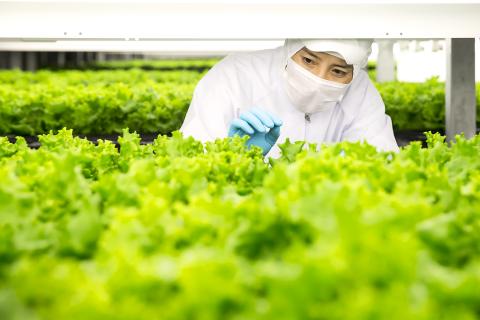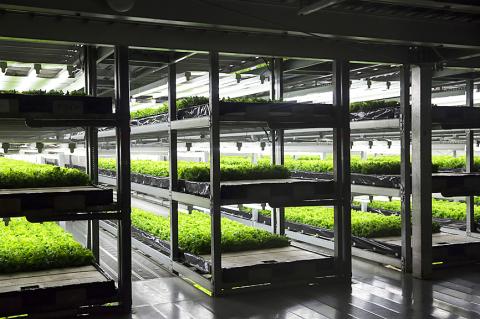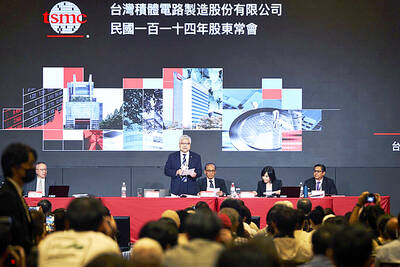High-rise indoor farms for vegetables are spreading across the world.
In a suburb of Kyoto City in Japan, surrounded by technology companies and start-ups, Spread Co is preparing to open the world’s largest automated leaf-vegetable factory. It is the company’s second vertical farm and could mark a turning point for vertical farming — bringing the cost low enough to compete with traditional farms on a large scale.
For decades, vertical farms that grow produce indoors without soil in stacked racks have been touted as a solution to rising food demand in the world’s expanding cities. The problem has always been reproducing the effect of natural rain, soil and sunshine at a cost that makes the crop competitive with traditional agriculture.

Photo: Bloomberg
Spread is among a handful of commercial firms that claim to have cracked the problem with a mix of robotics, technology and scale.
Its new facility in Keihanna Science City, known as Japan’s Silicon Valley, is to grow 30,000 heads of lettuce a day on racks under custom-designed LED lights. A sealed room protects the vegetables from pests, diseases and dirt. Temperature and humidity are optimized to speed growth of the greens, which are fed, tended and harvested by robots.
FIXED PRICE

Photo: Bloomberg
“Our system can produce a stable amount of vegetables of a good quality for sale at a fixed price throughout the year, without using pesticides and with no influence from weather,” Spread president Shinji Inada, 58, said in an interview at the company’s existing facility in Kameoka.
Inada won the Edison Award in 2016 for his vertical farming system.
He said he expects the new factory, called Techno Farm, to more than double the company’s output, generating ¥1 billion (US$8.8 million) in sales a year from growing almost 11 million lettuces.
About 60 percent of indoor farm operators in Japan are unprofitable because of the cost of electricity to run their facilities, while most others only turn a profit because of government subsidies or by charging a premium to consumers for vegetables that are chemical-free, the Japan Greenhouse Horticulture Association said.
Spread sells lettuces for ¥198 a head to consumers, about 20 to 30 percent more than the normal price for conventionally grown varieties, Inada said.
FREE FROM PESTICIDES
Consumers pay the premium because the pesticide-free vegetables are increasingly seen as an alternative to often more expensive organic foods, which must be grown outdoors in soil.
Japan’s hot summers and high humidity also make organic plants more vulnerable to insects and diseases, said Yasufumi Miwa, an expert at the Japan Research Institute.
“Producing organic vegetables requires farmers’ extra-hard work and that should be reflected in the prices,” said Takumu Okuma, spokesman for online food supplier Oisix ra daichi Inc. “Pesticide-free vegetables are seen as safe by consumers and accepted by them as a substitute for more expensive organic ones.”
Small-scale vertical farms have been operating in Japan since the 1970s, niche players that took advantage of high prices for fresh food in cities in a nation that imports about 60 percent of its food.
However, it was not until 2010 that the sector began to expand rapidly with the adoption of energy-saving LED lights and a government program to support innovative farming with subsidies, the association said.
Inada, a former vegetable trader, founded his company in 2006 and opened his first facility the following year in Kameoka in Kyoto Prefecture. The company spent years refining systems for lighting, water supply, nutrients and other costs, and the plant finally turned its first profit in 2013.
TECHNO FARM
Its new Techno Farm, expected to open as early as this month, is to push efficiency further, yielding 648 heads of lettuce a square meter annually, compared with 300 heads at its Kameoka farm and only five in an outdoor farm.
It will use only 110ml of water a lettuce, 1 percent of the volume needed outdoors, as moisture emitted by the vegetable is condensed and reused.
Power consumption per head is also to decrease, with the new factory using custom-designed LEDs that require about 30 percent less energy.
A collaboration with telecoms company NTT West on an artificial intelligence program to analyze production data could boost yields even more.
Spread does not disclose the cost of producing lettuce at its farms, but Japanese researcher Innoplex LLC estimates the cost to make one head of lettuce at its existing Kameoka building is about ¥80, among the lowest in the world.
Japan Research Institute said it expects production costs at the new Techno Farm to come close to parity with outdoor farms within about five years, but extreme weather events and climate change, major disrupters of traditional agriculture, are making vertical farming competitive even sooner. Japan’s hottest-ever summer this year with heavy rains, typhoons and flooding, sent supermarket lettuce prices soaring to more than double the level at which Spread retails its products.
CLIMATE CHANGE
“Climate change is affecting food production almost everywhere, and the economics of growing and selling produce is affecting everyone,” said Dickson Despommier, professor emeritus of Public and Environmental Health at Columbia University, who has been promoting the idea of vertical farming since the 1990s.
“If we don’t do something soon to reduce the rate of climate change, vertical farming may be our last hope of getting food on the table for all those who live in cities,” he said.
Around the world, many existing vertical farms are located in climates that are inhospitable for vegetable farming and have high transport costs to import fresh produce, or in places where pollution concerns created a demand for “clean” food, such as in China.
ANTARCTIC LETTUCE
In Antarctica, where weather conditions prevent shipments of supplies for much of the winter, scientists at Germany’s Neumayer-Station III harvested their first batch of indoor lettuce, cucumbers and radishes this year to feed the station’s staff, while in space, astronauts grow food on the International Space Station in a mini farm nicknamed Veggie.
Some commercial ventures have targeted wealthy nations in the Middle East as prime candidates for vertical farms, because of the high cost of importing fresh produce.
Dubai’s Emirates Flight Catering plans to begin construction next month of a 12,077m2 vertical farm to supply airlines in a venture with California-based Crop One Holdings. The US$40 million facility is expected to deliver its first vegetables to airlines and airport lounges in December next year.
Other high-rise farms have appeared in office towers or condos as part of the design. In Tokyo’s Ginza shopping area, stationary retailer Itoya tends a vertical farm on the 11th floor of its 12-story building to supply lettuces exclusively to its cafe, at a cost that would be uncompetitive with vegetables grown in outdoor farms.
GREENHOUSE RIVALS
One of the biggest challenges to the wide-scale adoption of vertical farms is the rise of massive greenhouse-based operations outside cities that employ many of the same technologies, such as the UK’s Thanet Earth, which grows millions of tomatoes, peppers and cucumbers a year under glass. While these farms need more land, they harness natural sunlight, reducing power costs.
Thanet Earth describes itself as the country’s largest greenhouse complex.
In Japan, where the workforce is aging and many companies have relocated production overseas, vertical farms can also be built in idled factories.
JX ANCI, a wholly owned subsidiary of JXTG Nippon Oil & Energy Corp, plans to build an indoor farm in its Narita plant by 2020, using Spread’s system. Mitsubishi Gas Chemical Co Inc has agreed with Farmship Inc, a Tokyo-based start-up established by a former Spread employee, to build an indoor farm that would grow 32,000 lettuces a day in Fukushima Prefecture.
The real race though, is to go global. Spread plans to export its farming system to more than 100 cities worldwide, competing with companies such as Crop One Holdings, Plenty Inc of the US and Sanan Sino-Science Photobiotech Co Ltd of China.
Spread has signed an agreement with a food producer in the United Arab Emirates to supply its system and is holding talks with about 300 other companies and researchers, Inada said.
“We are targeting countries where fresh vegetables cannot be produced because of scarce water, extremely low temperatures or other natural conditions,” Inada said. “Our mission is to provide infrastructure for vegetable production to anybody, anywhere in the world.”

With an approval rating of just two percent, Peruvian President Dina Boluarte might be the world’s most unpopular leader, according to pollsters. Protests greeted her rise to power 29 months ago, and have marked her entire term — joined by assorted scandals, investigations, controversies and a surge in gang violence. The 63-year-old is the target of a dozen probes, including for her alleged failure to declare gifts of luxury jewels and watches, a scandal inevitably dubbed “Rolexgate.” She is also under the microscope for a two-week undeclared absence for nose surgery — which she insists was medical, not cosmetic — and is

CAUTIOUS RECOVERY: While the manufacturing sector returned to growth amid the US-China trade truce, firms remain wary as uncertainty clouds the outlook, the CIER said The local manufacturing sector returned to expansion last month, as the official purchasing managers’ index (PMI) rose 2.1 points to 51.0, driven by a temporary easing in US-China trade tensions, the Chung-Hua Institution for Economic Research (CIER, 中華經濟研究院) said yesterday. The PMI gauges the health of the manufacturing industry, with readings above 50 indicating expansion and those below 50 signaling contraction. “Firms are not as pessimistic as they were in April, but they remain far from optimistic,” CIER president Lien Hsien-ming (連賢明) said at a news conference. The full impact of US tariff decisions is unlikely to become clear until later this month

GROWING CONCERN: Some senior Trump administration officials opposed the UAE expansion over fears that another TSMC project could jeopardize its US investment Taiwan Semiconductor Manufacturing Co (TSMC, 台積電) is evaluating building an advanced production facility in the United Arab Emirates (UAE) and has discussed the possibility with officials in US President Donald Trump’s administration, people familiar with the matter said, in a potentially major bet on the Middle East that would only come to fruition with Washington’s approval. The company has had multiple meetings in the past few months with US Special Envoy to the Middle East Steve Witkoff and officials from MGX, an influential investment vehicle overseen by the UAE president’s brother, the people said. The conversations are a continuation of talks that

CHIP DUTIES: TSMC said it voiced its concerns to Washington about tariffs, telling the US commerce department that it wants ‘fair treatment’ to protect its competitiveness Taiwan Semiconductor Manufacturing Co (TSMC, 台積電) yesterday reiterated robust business prospects for this year as strong artificial intelligence (AI) chip demand from Nvidia Corp and other customers would absorb the impacts of US tariffs. “The impact of tariffs would be indirect, as the custom tax is the importers’ responsibility, not the exporters,” TSMC chairman and chief executive officer C.C. Wei (魏哲家) said at the chipmaker’s annual shareholders’ meeting in Hsinchu City. TSMC’s business could be affected if people become reluctant to buy electronics due to inflated prices, Wei said. In addition, the chipmaker has voiced its concern to the US Department of Commerce